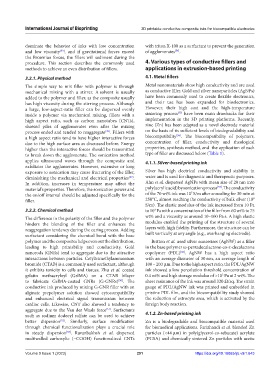Page 299 - IJB-9-1
P. 299
International Journal of Bioprinting 3D printable conductive composite inks for biocompatible electrodes
dominate the behavior of inks with low concentration with triton X-100 as a surfactant to prevent the generation
and low viscosity , and if gravitational forces exceed of agglomerates .
[33]
[54]
the Brownian forces, the fillers will sediment during the
procedure. This section describes the commonly used 4. Various types of conductive fillers and
methods to achieve an even distribution of fillers. applications in extrusion-based printing
3.2.1. Physical method 4.1. Metal fillers
The simple way to mix filler with polymer is through Metal nanomaterials show high conductivity and are used
mechanical mixing with a stirrer. A solvent is usually as conductive filler. Gold and silver nanoparticles (AgNPs)
added to the polymer and filler, as the composite usually have been commonly used to create flexible electronics,
has high viscosity during the stirring process. Although and their use has been expanded for bioelectronics.
a large, low-aspect-ratio filler can be dispersed evenly However, their high cost and the high-temperature
[55]
inside a polymer via mechanical mixing, fillers with a sintering process have been main drawbacks for their
high aspect ratio, such as carbon nanotubes (CNTs), implementation in the 3D printing platforms. Recently,
showed piles of agglomerates even after the mixing zinc (Zn) has been adapted as a novel electrode material
process ended and tended to reaggregate . Fillers with on the basis of its sufficient levels of biodegradability and
[49]
[56]
a high aspect ratio tend to have higher interactive forces biocompatibility . The biocompatibility of polymers,
due to the high surface area as discussed before. Energy concentration of filler, conductivity and rheological
higher than the interactive forces should be transmitted properties, synthesis method, and the application of each
to break down the agglomerate. The sonication method type of filler are discussed below (Table 1).
applies ultrasound waves through the composite and 4.1.1. Silver-based printing ink
exfoliates the agglomerates. However, extensive or long
exposure to sonication may cause fracturing of the filler, Silver has high electrical conductivity and stability in
[32]
diminishing the mechanical and electrical properties . water and is used for diagnostic and therapeutic purposes.
In addition, increases in temperature may affect the Ahn et al. dispersed AgNPs with mean size of 20 nm into
[57]
material’s properties. Therefore, the sonication power and poly(acrylic acid) by sonication process . The conductivity
7
the on/off interval should be adjusted specifically for the of the 70 wt% ink was 10 S/m after annealing for 30 min at
8
filler. 250°C, almost reaching the conductivity of bulk silver (10
S/m). The elastic modulus of the ink increased from 10 Pa
3.2.2. Chemical method to 10 Pa with a concentration of the filler from 60 wt% to 75
4
The difference in the polarity of the filler and the polymer wt% and a viscosity as around 10–100 Pa∙s. A high elastic
hinders the blending of the filler and enhances the modulus enabled the printing of the structure of several
reaggregation tendency during the curing process. Adding layers with high fidelity. Furthermore, the structure can be
surfactant considering the chemical bond with the base built vertically at any angle (e.g., overhanging electrode).
polymer and the composites helps even out the distribution, Britton et al. used silver nanowires (AgNW) as a filler
leading to high printability and conductivity. Gold in the base polymer ω-pentadecalactone-co-ε-decalactone
nanorods (GNRs) tend to aggregate due to the attractive copolymer (PDL) . AgNW has a high aspect ratio
[58]
interactions between particles. Cetyltrimethylammonium with an average diameter of 30 nm, an average length of
bromide (CTAB) is a commonly used surfactant, although 100 – 200 µm. Due to the high aspect ratio, the PDL/AgNW
it exhibits toxicity to cells and tissues. Zhu et al. coated ink showed a low percolation threshold concentration of
gelatin methacryloyl (GelMA) on a CTAB bilayer 0.4 wt% and high storage modulus of >10 Pa at 2 wt%. The
5
to fabricate GelMA-coated GNRs (G-GNRs) . The sheet resistance of the ink was around 320 Ω/sq. The strain
[50]
conductive ink produced by mixing G-GNR filler with an gauge of PDL/AgNW ink was printed and embedded in
alginate prepolymer solution showed cytocompatibility pristine PDL film, and the biocompatibility study showed
and enhanced electrical signal transmission between the reduction of astrocyte area, which is activated by the
cardiac cells. Likewise, CNT also showed a tendency to foreign body reaction.
aggregate due to the Van der Waals force . Surfactants
[51]
such as sodium dodecyl sulfate can be used to achieve 4.1.2. Zn-based printing ink
better dispersion . Similarly, surface modification Zn is a biodegradable and biocompatible material used
[52]
through chemical functionalization plays a crucial role for biomedical applications. Farizhandi et al. blended Zn
in steady dispersion . Ravanbakhsh et al. dispersed particles (<44 µm) in poly(glycerol-co-sebacate) acrylate
[53]
multiwalled carboxylic (−COOH) functionalized CNTs (PGSA) and chemically sintered Zn particles with acetic
Volume 9 Issue 1 (2023) 291 https://doi.org/10.18063/ijb.v9i1.643

